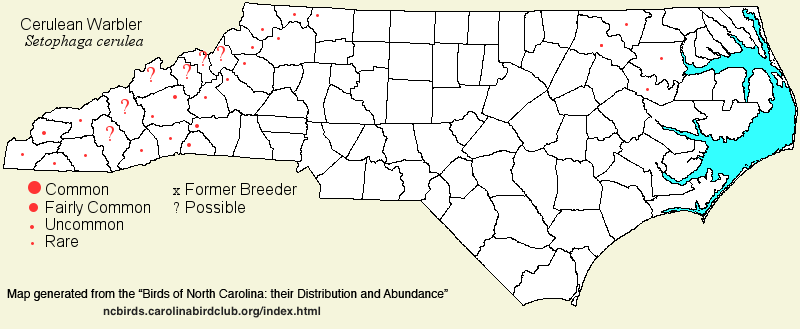 |  |
|
Cerulean Warbler - Setophaga cerulea PARULIDAE Members: | Search Common: Search Scientific: |
|
|
|||||||
| General Comments | The Cerulean Warbler is one of the more strongly declining songbirds in the eastern part of the continent. It was petitioned to list as Federally Threatened about a decade ago, but the petition failed, as the U.S. Fish and Wildlife Service felt that the species was still too numerous to list. It nests in mature deciduous forests in the northeastern quadrant of the country, but mainly to the north and west of North Carolina. In our state, nesting occurs mainly in the mountains, and along the Roanoke River. It does migrate through the remainder of the state, but as it is a rare bird, it is a red-letter find for most observers. Breeding habitat in the mountains is quite specific -- mature deciduous forest on steep slopes, usually with grape vines, and often with much Tuliptree, and a lush herb layer. Most sites have an open view "off-slope" -- i.e, it does not nest in cove forests with a facing slope, but it favors sites along the Blue Ridge Escarpment (and is mostly absent on rich slopes elsewhere). Along the Roanoke, it typically nests in tall hardwood trees along levees immediately next to the river, though a few birds occur along streams nearby. Sadly, the species has declined as a breeder in recent years, and can now be hard to find along the Roanoke and at a few sites where formerly present in the mountains. | ||||||
| Breeding Status | Breeder | ||||||
| NC BRC List | Definitive | ||||||
| State Status | SC | ||||||
| U.S. Status | |||||||
| State Rank | S2B | ||||||
| Global Rank | G4 | ||||||
| Coastal Plain | Local summer resident, and sparse transient. In summer, rare to uncommon, local, and declining, along the Roanoke River from Roanoke Rapids downstream to the Williamston area; a few occur along adjacent streams. There are one or two summer records from the Neuse River in Johnston, but no evidence that such birds stayed for the summer. Elsewhere, very rare in both spring and fall, including along the coast in fall. Mainly late Apr to mid-May, and late Aug to late Sep, sparingly to mid-Oct. Peak counts: 25, Roanoke Rapids spring count, 4 May 1975. | ||||||
| Piedmont | Transient; breeds along the Blue Ridge Escarpment, which forms the border between the Piedmont and Mountains (see Mountains). It may have nested in Greensboro in 1930. Rare in both spring and fall across the region; slightly more "numerous" in the western half, but still a rare bird everywhere in the region. Mainly late Apr to mid-May, and mid-Aug to late Sep. Peak counts: | ||||||
| Mountains | Summer resident, and transient. In summer, mostly rare and local at lower elevations (below about 3,800 feet), but can be fairly common in a very few areas; strongly declining. Breeds at scattered small colonies along the Blue Ridge Escarpment, formerly in Wilkes, but now from Ashe to Rutherford (Chimney Rock Park) and Polk; additional areas include the Bull Mountain area northeast of Asheville, Yellow Creek Mountains near Fontana Village in Graham, and various scattered sites in Macon and surrounding counties. Absent over most areas of the mountains as a breeder. Poorly known as a transient, but presumably rare. Mainly mid-Apr to mid-Sep. Peak counts: 30 territorial males along the Blue Ridge Parkway northeast of Asheville in Jun 2002. | ||||||
| Finding Tips |
The species is best found by stopping at several overlooks on the Blue Ridge Parkway northeast of Asheville, between Craven Gap and Bull Creek Overlook; try from the end of Apr into early Jun. ** to *** | ||||||
| Attribution | LeGrand[2025-07-29], LeGrand[2025-02-06], LeGrand[2024-11-11] | ||||||
| NC Map Map depicts all counties with a report (transient or resident) for the species. | Click on county for list of all known species. |
| NC Breeding Season Map Map depicts assumed breeding season abundance for the species. |  |